Selling homes in Spain
|

|
|

|
Spain
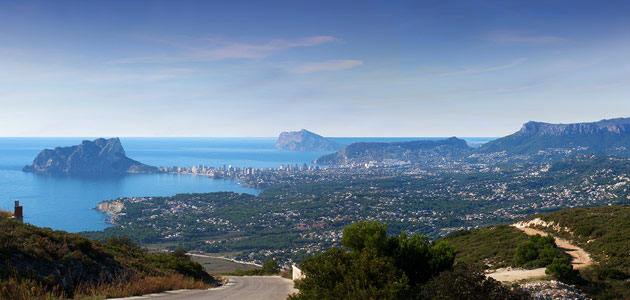
Spain is a democratic country, part of the European Community, with population of 44 millions of people. It is believed that there are about 1 million foreign-owned properties hosting approximately 3 million persons per year (almost 10% of the population). Over 50 millions of tourists visit Spain each year, so tourism is one of the principal sources of employment.
The climate of Spain can be divided practically into three zones: Atlantic, continental and Mediterranean. Mediterranean, in the south, is the warmest one in the country and has an average temperature of 34ºC in summer and 13 hours of bright sunshine per day. The Mediterranean area has also a pleasant climate in winter, with little rain.
Since 1492 Spain has been mainly Roman Catholic country. The 1931 Constitution established a secular state and secularized education. Currently, the Constitution guarantees freedom of religious expression and religious festivals are celebrated with colorful local traditions, including folk dances and processions.
The Valencian Community
Welcome to Valencian Community! We hope you want to know all about the multitude of attractions and activities offered by this region, and about the friendly nature that characterizes the 5 million of Valencians, who will help you to enjoy your stay.
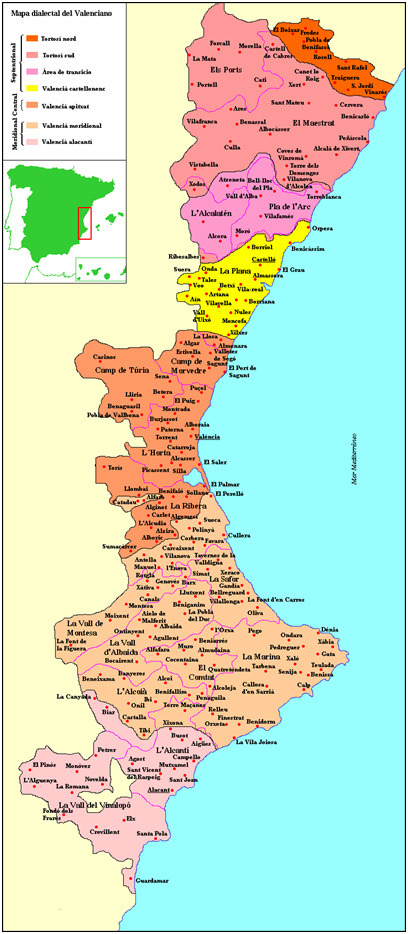
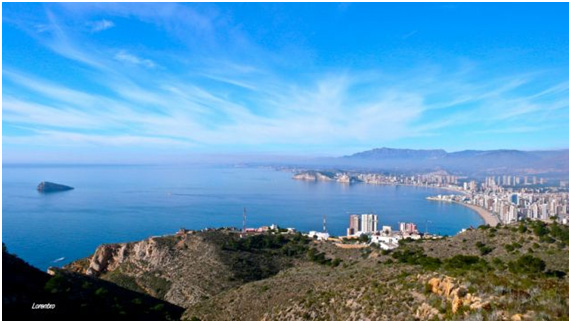
The Valencian Community is located on the east coast of the peninsula and covers 23.500m ² of the Mediterranean area. The coast has a length of 244km and borders Catalonia in the north and Murcia in the south. The coast of each province has its own name: The Costa del Azahar in Castellón, Costa de Valencia in Valencia and the Costa Blanca in Alicante, where you can enjoy the sea and the sun enhanced by a rich culture born at the dawn of the times. These hundreds of kilometers of the excellent sandy beaches offer a warm sea in summer and in autumn and bright sunshine even in winter. You will see blue flags waving in many beaches, which are awarded by the European Community in recognition of cleanliness, good water quality and selected service. The Valencia region has a warm climate with an average temperature in 18 º C in winter and about 31 ° C in summer.
La Costa Blanca
The Costa Blanca is undoubtedly one of the most attractive destinations in Europe to enjoy the sun and the beaches being in full contact with nature. Located in the Spanish Mediterranean, Costa Blanca is the tourist name of the Province of Alicante. This area is blessed not only with mild, healthy climate, but also with its natural environment: the beaches of fine golden sand, and in the interior, green valleys with fertile orchards which contrast with low mountains, harboring charming and picturesque Mediterranean villages. The sun shines almost all year round allowing water sports and swimming at any season of the year. In addition, the natural landscape and parks are suitable for hiking, horseback riding, cycling or mountaineering.

A network of rural properties, family hotels, hostels, campings and different activities offers alternatives to sunbathing on the beach. Hiking, mountaineering, climbing or mountain biking - in this way you can get to know better the Mediterranean interior.
Throughout the history Iberians, Carthaginians, Romans and Muslims established important populations in this country, leaving many traces dispersed across the province. Currently, many European tourists travel to Spain and many of them decide to stay here. Archaeological excavations, huge castles, churches carved in the stone, extraordinary public buildings and developed infrastructure allow to appreciate the richness and variety of the culture of the Costa Blanca.
Its attractive beaches, the beautiful landscape, well preserved natural environment, climate, modern communication services, together with the open and cosmopolitan spirit of its people have transformed the Costa Blanca in a privileged place to live. Moreover, many Europeans have chosen the Costa Blanca as an ideal destination for their holidays.
The infrastructure of the Costa Blanca
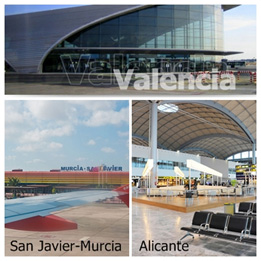
The Costa Blanca is one of the most important tourist centers in Europe. It has developed a network of communication infrastructures that make it accessible to anyone from any place in the world. The Costa Blanca has 3 international airports: Valencia, Alicante and San Javier. Alicante airport transports about 5 million passengers per year, and more than half of them come from Europe.
Entering the new millennium, the railway has been undergoing a profound transformation with ultra locomotives able to go over 200 km/h.
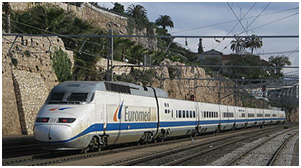
The Euromed connects Alicante and Valencia with Tarragona and Barcelona. It is one of the most modern and fast trains in Spain, reaching a speed of 220 km/h.
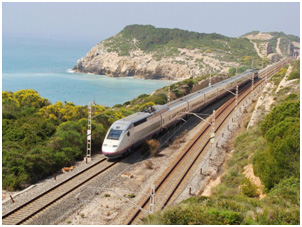
The AVE, communicates Alicante to Madrid at high speed.

Alicante has everything to become one of the major cruise ports in the Mediterranean.
The services and amenities increase daily. There are also three maritime passenger terminals in Valencia, Denia and Alicante, and a very complete network of motorways is connecting Costa Blanca with the main regions of Spain and Europe.
In the surroundings of Alicante there is an infrastructure of services in order to improve the leisure offer, trade shows and conferences. Alicante was chosen by the Government of Spain as the seat of the Spanish Patent and Trademark Office. Furthermore, the Office for Harmonization in the Internal Market of the European Community is located in this area, near the airport and major business centers.
Culture and landscapes of the Costa Blanca
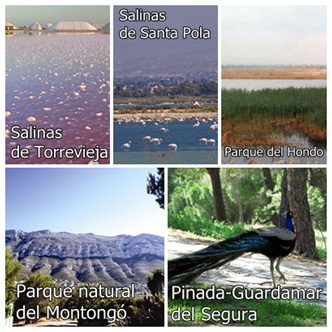
In the interior of the coastal plain in the northern half of the mountain, there is the Montgo natural park flying over Denia and Javea bays; its native flora ranges from the broom to the wild orchid. This landscape contrasts with the south, where we find in Elche and Orihuela palm forests, the natural park of El Hondo, also located in Elche, the Salterns of Santa Pola, where flamingos are nesting, Torrevieja Lagoons, and dunes and pine forests of Guardamar del Segura.
Alicante has rich natural contrasts thanks to the peculiarity of mountains that rise the Mediterranean landscape. The inner areas of the Mediterranean amaze visitors with unique images, thanks to the natural wealth of the province and its open and cosmopolitan people. In the Canelobre Caves in Busot, stalactites and stalagmites adopt fantastic shapes... And in the coastal region, the beaches alternate between geographical accidents, so singular and emblematic as the Rock of Ifach in Calpe, the Cape of San Antonio and Cabo de la Nao, the island of Benidorm or the cliffs of the Sierra Helada and Benitachell. These destinations are the ideal complement to the main coastal resorts, and are not far from the beach.
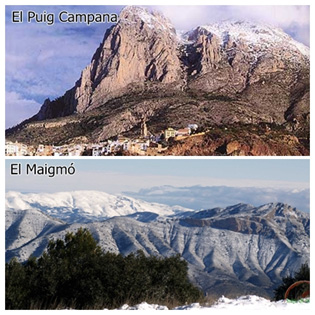
You can also find some giant mountains: the Puig Campana with Finestrat at his feet and witness to the Babylonian Benidorm; Maigmó with lush green pine forests, perfumed by the fragrance of Mariola herb fields.
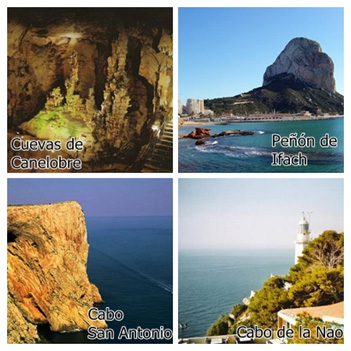
Canelobre Caves, Peñón de Ifach, Cabo San Antonio and Cabo de la Nao.
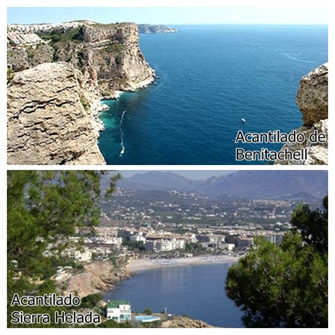
Benitachell Cliff and Sierra Helada Cliff.
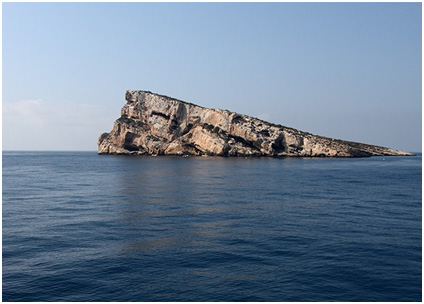
Benidorm Island
The Middle Ages contributed to the province of Alicante with important constructions. There are many castles and forts across the province. The largest concentration of them can be found following the Vinalopó river valleys, these buildings were necessary for defensive purposes in the age of pirates. Alicante Province had an important role in the history of the crowns of Castile and Aragon. Here was signed the agreement D'Almizra, which determined the union of the two crowns and put an end to war.
Celebrations of the Costa Blanca
If there is a trait that describes the 415 festivities, it’s undoubtedly the ability they have to appeal to all audiences and convert them by mere participation in "protagonists". The Costa Blanca is rich in folklore, celebrations and traditions.
No doubt, the Moors & Christians is the celebration where everyone participates. It recreates the Middle Ages celebrating the Christian reconquest of the land that the Arabs ruled for several centuries. Alcoy is the village where these festivals are the most important and ostentatious, but similar events take place throughout the province. It is also worth mentioning the Bonfires of San Juan in Alicante, as well as the famous Alborada on 13 August in Elche. Throughout the year the specialists are building huge cardboard figures, which are burned in a purifying fire on the night of June 24. Also noteworthy are Easter celebrations.
Activities and tourism on the Costa Blanca
The Costa Blanca offers plenty of opportunities for visitors. A wide choice of routes, from the coastal area to the mountains, its natural attractions, warm weather, and human effort have made possible a very rich and professional tourism industry offering a plenty of possibilities to enjoy sports or adventures, in the middle of a beautiful natural environment.
The Costa Blanca offers endless opportunities for water sports. From sailing to surfing, from scuba diving to fishing, the coastline of the region is a paradise for water sports lovers. Most of them are organized by clubs and seaports. Many competitions and courses for beginners and advanced level take place. This services and water quality have been awarded by the Environment Agency of the European Community.
Traveling around the Costa Blanca will offer you the opportunity to discover the local products of each town, made in accordance with popular tradition, using raw materials of each region. Despite the magnitude of the industry, you can still find many artisans, who inherited from their ancestors an art that often predates the Middle Ages, even before the Arab civilization, as in the case of ceramics. Another typical artisan product of the Costa Blanca is the basketry. In Gata de Gorgos you can see how to do all kinds of palm fibre products: hats, baskets and furniture.
Finestrat: Terra Mitica is the first theme park in Valencia with five exciting areas where visitors can learn in a funny way about the Mediterranean ancient civilizations: EGYPT, the bazaar of dreams, where you can paddle in the port of Alexandria and in the pyramids you’ll share the pharaoh’s secrets during impressive performance; GREECE, the place of the gods, where you can relive the emotions of the Olympic Games and get lost in the famous maze of the Minotaur of Crete; ROME, the border, here you’ll cross the bridge of Merida to experience the military atmosphere, beatings and, on the top, you will vibrate on a wooden roller coaster; IBERIA, the warm shore, here you can travel to the XVII and XVIII centuries and experience life of Valencia in the past and in present. All the fun you can dream, on dazzling shows; ISLANDS, the great journey, making the legendary voyage of Ulysses around the Mediterranean, the heart of the theme park offers unimaginable adventures, the funniest water rides, mechanical breathtaking rides , and for children, a miniature copy of all park's attractions.

Terra Mítica map.
Gastronomy of the Costa Blanca
The Costa Blanca has a rich and varied cuisine. From north to south and from east to west, the traditional cuisine of the province has produced foods based on fish, rice, meat, vegetables and various fruits.
Alicante’s gastronomy is rich in oils, vegetables, fruits, seafood and rice dishes. Most of the ingredients of the "Mediterranean diet" are considered among the healthiest in the world. The province is also famous for its sweets. One of the most typical is the "nougat", which was introduced by Arabic culture and is made from almonds and local honey; it is eaten mainly during the Christmas holidays.
The most exported product of Valencia is citric. This represents 80% of the Spanish production and it is exported to all countries of Europe. Other important products of the province are olive oil, leather shoes, toys and various types of wines. If you are interested in handicraft, you will find traditional pottery, baskets, fans and furniture made with traditional methods typical in the area.
Villages and towns in the interior of the Costa Blanca.
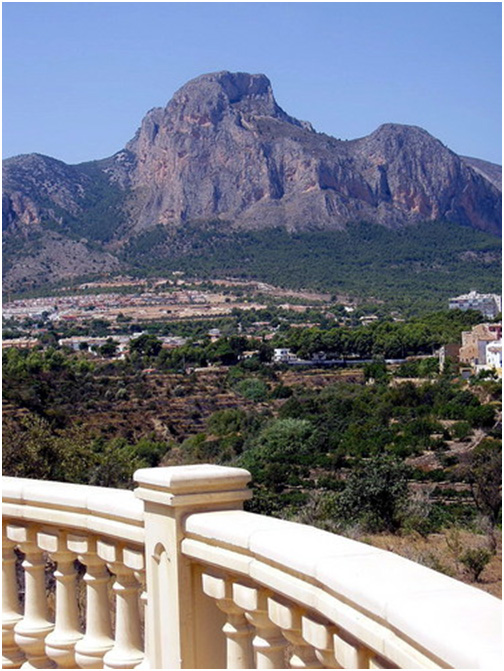
La Nucía: Going inland from Benidorm, about 5km away there is the small and charming town of La Nucia on flat land at the foot of the mountain of Forques, with white washed houses and narrow streets typical of a Mediterranean village. Most people come to La Nucia on Sundays to walk through the streets with balconies adorned with flowers, browse through the famous flea market, visit the church of Renaissance architecture and spend time in a location nearby called Font of Favara. The history of this small village dates from 1250, when the troops of King James I occupied what was an Arab stronghold and later became the barony of Polop, the neighboring village. In 1609, the remaining Arabs were replaced by colonies from another part of Spain and the population continued its slow growth up to the number of about 7,000 people, all proud to be 'Nucieros' and telling themselves that Benidorm is their coastal neighborhood.
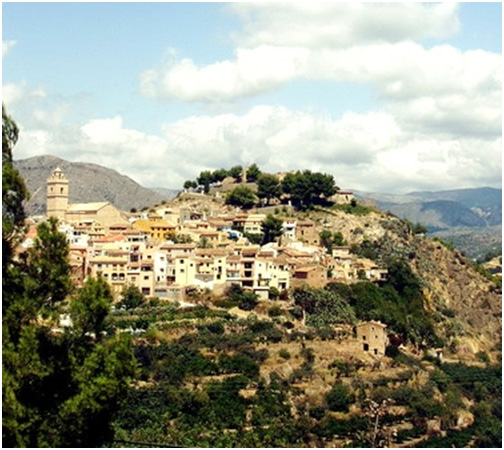
Polop: Two kilometers further you’ll find the town of Polop. The author Gabriel Miró said, "I recently discovered a lovely place, which seems have been lulled by years." Located on a hill surrounded by lush vegetation, Polop was once the most important town in the area, especially in the years after the expulsion of Arab colonies. With its steep streets, white washed walls and antique doors, this old town has an air of tranquility, though many people visit it, bringing containers to fill with water from a splendid source. There are 221 jets that feed the icy waterfalls of Cotelles and Garrofet, pure water that is renewed by natural elements and has exquisite taste. Another exquisite flavour you can taste in a village restaurant that cooks local dishes in an Arabic oven. The attractive old quarter of the village has a parish church, and a steep path that leads to the castle ruins. Recently it has been used as a cemetery, described by Miró as a 'garden of crosses', and today you can enjoy here the beautiful natural environment surrounding the town, full of orange groves, lemon and medlar trees.
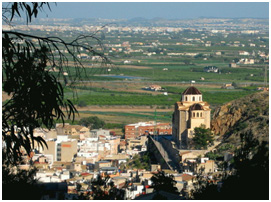
Callosa: If you travel a few more miles up to Callosa d'en Sarria, you will appreciate the agricultural nature of this town, dating from the twelfth century. Located on a southern slope of a hill, with an average temperature of 17 ° C, it has a typical Mediterranean climate, warm and constant, ideal for fruit production, especially for medlar, with a production of approximately 17 million kilos per year. The town ownes its name to Admiral Bernat de Sarria, which bought the area in 1290, and turned it into a state that covered most of the Marina Baja, passing through different noble families up to the Counts of Orgar in 1767, who are the current owners. The village is famous for its archiepiscopal neoclassical church of St. John the Baptist, opened in 1568 and subsequently renewed on several occasions. Nowadays monthly concerts are held here. The fort at the top of the hill was built by the order of King Philip II with the intention to defend the coast against the attacks of the Turkish Ottoman Empire. In this village there is also the first archaeological and ethnic museum of Marina Baja, with a permanent exhibition of the life of ancient Callosa’s life.
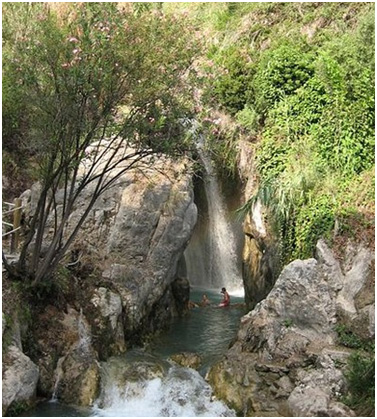
Las Fuentes de Algar. Many visitors who come here decide to travel three kilometers more to the Fuentes de Algar. Although it is a natural phenomenon, these sources are now a protected reserve. Unspoiled, because they are in a specially protected area and it was decided to carry out an extensive program of preservation of this unique scenery. In order to reverse the damage already done and to ensure the rehabilitation and conservation of the site, all facilities were carried through respecting the environment. There are clearly marked paths, flanked by common reed, bamboo or laurel, with maps in different languages that guide visitors through this natural water park with its authentic pools of clear water. There are also barbecue areas, campgrounds and restaurants that help visitors to enjoy their stay here. In the upper valley, above the bathing place, there is a large open area provided with all amenities - barbecues, tables, benches, toilets and showers. Another area is designed for one more camping of 2nd category, and there is the reception and administration of the camping, and they are planning to build a museum of water.
Fuentes de L’Algar.
Guadalest: The mountain village of Guadalest is an historic-artistic complex divided into two districts. Castle district, which can be reached through a tunnel in the rock, hanging from the top of the mountain protected by an ancient medieval wall, and the Arrabal neighborhood, or modern district, which stretches around the foothill of the mountain. There are many people coming to this beautiful area, which last year was the second most visited place in Spain reaching two million of visitors. Located in the highest part of the top of the mountain, the town looks at the deep valley where river Guadalest flows. The landscape has abundant pine forests interspersed with fruit crops. The most cultivated fruit is the medlar, followed by apples, cherries and figs; as well as honey produced here is one of the best in the area. Inside the village, the historic character becomes evident with the Bethlehem Museum, the tunnel carved into the rock that gives access to the town, the walls and the church which is next to the Place de la Orduna, where scrolls from 1555 demonstrate Moorish domination over the people. Going up, you will cross more museums and craft shops, and the village extends upward, at 590 meters over sea level. From here you can see the two castles and the wall surrounding the church and the houses of the village, the village whose fame is due to its image, the rocky outcrop at the tip above the belfry. There is no lack of good food offer in the town with local cuisine containing traditional dishes such as paella, stuffed peppers, baked vegetables or rabbit "ali oli".
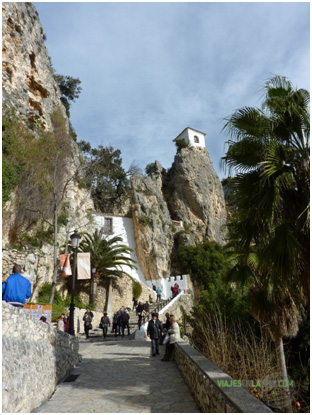
The Guadalest Castle.
Castalla: Historically it is the capital of the "Foia of Castalla", a wide valley facing southwest, situated between several mountains with a forest area of more than 46% in its municipal area. Traditionally it is an agricultural village, which is highlighted by plantations of olives, grapes and almonds, but today it is also characterized by production of toys, furniture and building materials. However, its most prominent feature is the delicious cuisine, being the "Gazpatxo" the dish you are obliged to try when visiting this town. Castalla is located only 30km from Alicante and about 10km from the neighboring villages, offering a wide range of sports and outdoor activities, and the gorgeous architectural history beginning in the sixteenth century. It also offers the most beautiful and clean landscape where you can enjoy your leisure.
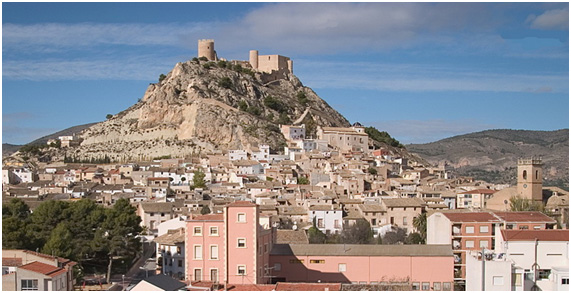
Panoramic photo of Castalla
Benissa: Intentionally built inland from the coast to escape the Berber attacks, the streets of the historic old town of Benissa descend downhill in a gradual manner. In the town there is one long main street shaded with orange trees, and it seems to be very far away from the confusion of the big coastal resorts. Lovely old houses and mansions, the gable and porch designs clearly Moorish, and the windows protected by the traditional rejas, line streets such as the Calle de la Purísima. The church of the Purísima (La Catedral de la Marina) dominates the central place, planted with palms and dewed by fountains. At the top of the town stands the Franciscan Convento de la Purísima , and there's an odd little Museo Etnográfico (ethnographic museum) in the 15th-century agricultural exchange (La Lonja).Once again Benissa beaches have been awarded by the Qualitur flag of quality and environmental management. In 2013 Benissa also received 4 blue flags, in recognition of the high environmental quality and the good services of its beaches and surroundings.
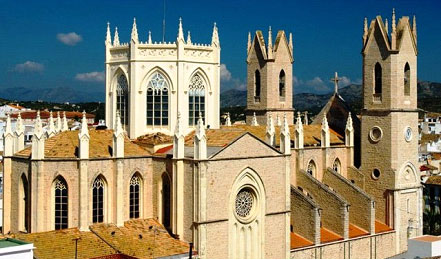
The Cathedral of Benissa
Elche: in the inland, about 13 km away from the beach and 15 km from Alicante, you’ll find this town with its two World Heritage Sites: The Palm Grove and The Misteri d’Elx. They say that for every resident of the city there is a palm tree. Because indeed, the palm trees here wrap themselves around everyday life. And the Municipal Park, an oasis in the middle of the city, incorporates a number of palm groves within its six hectares. The Huerto del Cura Garden, privately owned and declared a National Artistic Garden, was visited by the Empress Elisabeth of Austria, Sissi, in 1894. This garden owns the very famous Imperial Palm, a unique date palm with seven branches born from the same trunk. Those one who want satisfy their curiosity, can visit The Palm Grove Museum or immerse themselves into an idyllic natural world taking the Palm Grove Walk.
Another famous icon of the city is The Misteri d’Elx, declared the Masterpiece of oral and Intangible Heritage. It is a chanted drama in Valencian language, with Medieval, Renaissance and Baroque melodies. The play tells about the Dormition, Assumption to heaven and Coronation of the Virgin.
Elche is one of the references of European footwear production, concentrating over 40% of companies in the footwear sector. Today, the footwear industry is not only one of the pillars of the economy of the city, but it is also highly competitive on the international markets.
The variety of pomegranate "Mollar of Elche" is among the most valuable in the world for its particular sweetness, lack of seed and the numerous health benefits. Currently the request for the specification of the Designation of Origin (PDO) of Granada Mollar of Elche was launched.
Another internationally famous fruit grown in Elche is melon de carrizal. There are two varieties: yellow and pintasapo, distinguished from the rest by their extreme sweetness. The secret is in the saltiness of the land where it is grown.
Elche is also homeland of one of the most famous sculptures in the world: The Lady of Elche. This is a female bust carved in sandstone that is dated between the V and IV century BC. This sculpture still hides many mysteries. It is unknown whom represents the bust, and the function of the cavity in the back of it is also unknown. Currently the sculpture is exhibited at Madrid's National Archaeological Museum of Spain.
Elche has a modern public university known for its research activities.
The 9 kilometres of unspoilt coastline have a unique ecosystem, combining pine forests and dunes, with extensive beaches of golden sands, an exceptional feature due to its state of conservation, which is equipped with all the necessary services for respectful use. Almost all the beaches of the coastline of Elche enjoy Blue Flag status.
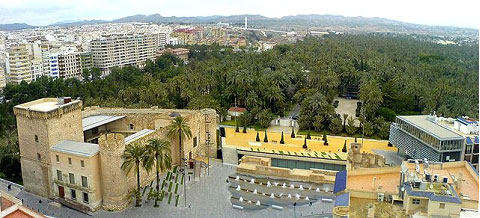
Overview of Elche
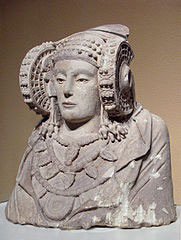
The Lady of Elche
Ciudad Quesada: a little town with 12500 inhabitants, located approximately 8kms in the inland of Costa Blanca at Guardamar del Segura. Alicante and Murcia airports are both 50kms away and the nearest beach is within 10 minutes drive.
You can find many bars, restaurants and shops in the town centre of Ciudad Quesada; it has also a golf course and its own water park. The area enjoys a typical Mediterranean climate, on average it can boast 325 sunny days each year making it an ideal all year round destination.
The many Blue flag beaches of are all within 15 minutes drive.
You can delight the palate with the ample wine list; and the local Jalon wine deserves a special mention due to its quality and bouquet. There are many international restaurants in the area, offering a wide choice of different cuisines from around the world.
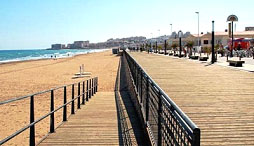
La Mata Beach
Orihuela: 60km southwest from Alicante you’ll find the ancient town of Orihuela. If your aim is a genuine historic inland town, you’ll be totally satisfied – its mix of monuments, palaces, noble buildings (six of them declared Cultural Heritage) will definitely impress you. The old part of the town was declared a historic-artistic and monumental area in 1969.
The municipality of Orihuela has several nature areas which are of paramount interest. The large and magnificent cultural heritage, the natural and architectural Orihuela, its traditional gastronomy will make you want to return.
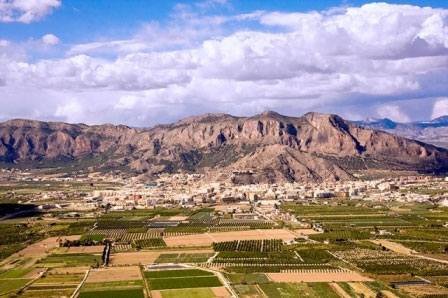
Orihuela
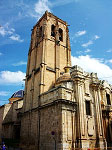
Church of the Saints Justa y Rufina
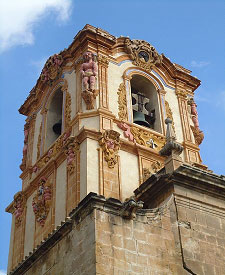
Santo Domingo College Tower
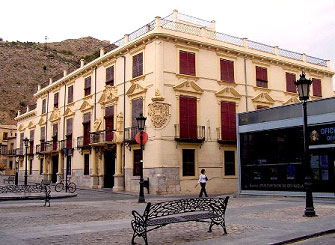
Marques de Rafal Palace
Cities of the Costa Blanca and its villages
Denia: the capital of the district of Marina Alta, is located 86km from Alicante and 96km from Valencia. The city lies along the Cape of San Antonio and in front of the Balearic Islands, which makes this place special, where the sea plays a key role. Denia has a coastline of 20km: northern beaches (Las Marinas) are wide and sandy, and in the south there are rocky coves (area of Las Rotas). It is known as a “city of healthy climate”, characterized by warm summers and mild winters. In fact, Denia even has a monument honouring the good weather. Prevailing winds in this area favour the practice of water sports. Denia is famous as one of the most favorable locations in Spain for windsurfing and kite surfing; it also has schools of sailing and a strong tradition in sailing regattas.
Among other attractions in the area we can mention the Marine Reserve, which is a natural area of high environmental value. Here you can realize a number of scuba diving tours, enjoying the beauty of the undersea world. Another place of interest and scenic value is Montgo Natural Park, where you can see various species of local flora and fauna and discover various hiking trails.
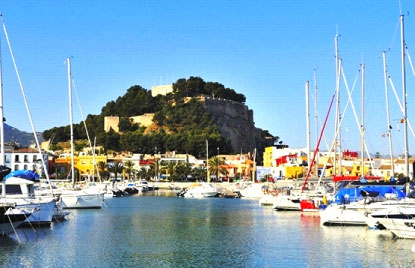
Denia port and castle
Jávea: Jávea is situated in a prime location in north the province of Alicante and is considered to be one of the most beautiful places bordering the Mediterranean's. It is the first peninsular municipality illuminated by the rays of the sun at dawn. The landscape of its extensive coastline presents alternation of rock coast that hides small coves with beautiful sandy Arenales beach. Jávea is located about 90 km away from Ibiza, and on clear days you can see the island.
This place is considered one of the best world microclimates. And the truth is that you can enjoy a comfortable temperature always, like the representatives of 85 nationalities living all year in Jávea are doing. The town has a large population of British (about 6000), Germans (2,000), Dutch, French, Italians, Russians, etc...
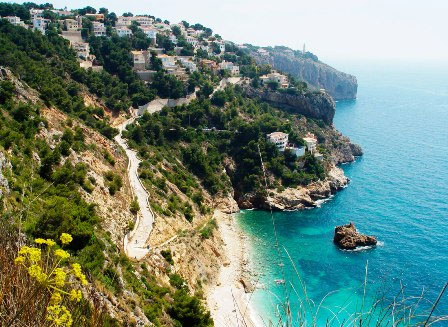
Coves of Jávea
Moraira: Moraira belongs to the municipality of Teulada, an important international resort. It has rocky coves and sandy beaches. Despite being a popular tourist destination, the town has preserved its originality and soul. The castle located on the beach is the symbol of Moraira.
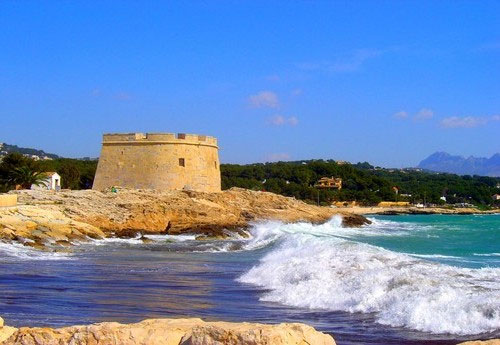
The Castle of Moraira
Calpe: the municipality of Calpe is located in the north of the province of Alicante, 63 km from the city of Alicante and 122 km from Valencia. The symbol of Calpe is Peñon de Ifach, a rocky mass 332 m high. Its presence creates a fascinating contrast between sea and mountains. Ifach, declared a Natural Park, turns the town into a place of extraordinary landscape attraction. But there are other places of singular beauty: coves and cliffs on the coast, rugged mountains in the interior. And a pretty picture: the natural landscape of the salterns, resting place of flamingo, heron and many other birds. From the nearly 30,000 residents of the municipality almost 60% are foreigners.The coast of Calpe (13km) offers an extensive line of excellent beaches; many of them are certified and awarded by Blue Flag. The town offers a rich agenda of activities for leisure and free time - local festivals, tours and excursions, museums and monuments, family tourism, nature, sports, urban spas ... The cultural program includes art exhibitions, theater performances music, films, etc.. Calpe is a place open to tourism, with its modern buildings and wide avenues; and at the same time it merges with the traditions of the fishing village and with the overwhelming majesty and beauty of the natural landscape. You will be surprised by its contrasts. It is a real treat for your senses!
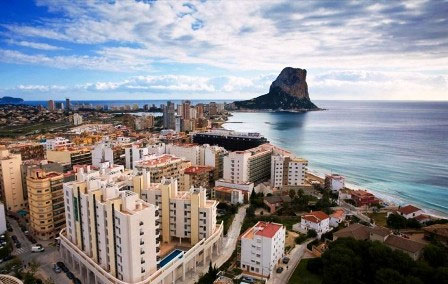
Calpe
Altea: protected and surrounded by steep hills and cliffs, Altea develops below the blue-tilled church of Our Lady of Consolation, located at the highest point of the picturesque village. A Roman settlement, born as a fishing village, Altea was restored by an artists' colony in the 1950s and a variety of painters, artisans and potters still live among its inhabitants. Their sense of style flows down the sheer white orange-shaded streets adorned with geraniums and full of tempting shops. These charms and the proximity of Altea to Benidorm inevitably attract large numbers of visitors. The beach is surrounded by a pleasant palm-lined promenade with a wide variety of bars and restaurants. Altea has also good facilities for water sports.
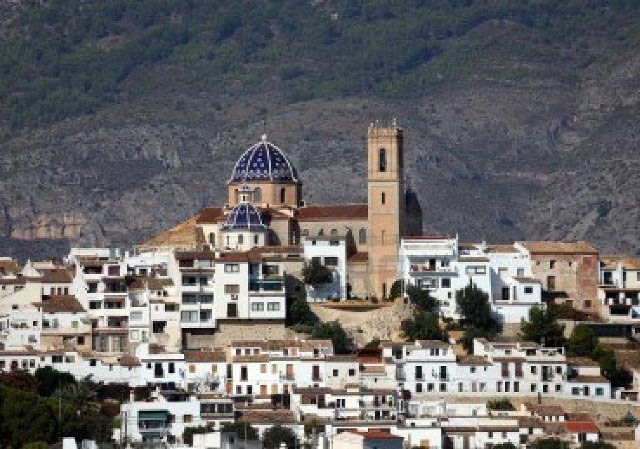
Altea. View of the town
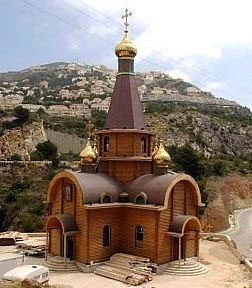
Altea. Iglesia Ortodoxa Rusa
Benidorm: It is the perfect place for lovers of the Spanish "marcha", clubs and nightlife for all ages. It is located about 50km north from Alicante. It is a tourist center where people of all nationalities meet each other and where considerably large British community is installed; it also offers wonderful beaches that are benefited by an exceptional microclimate.
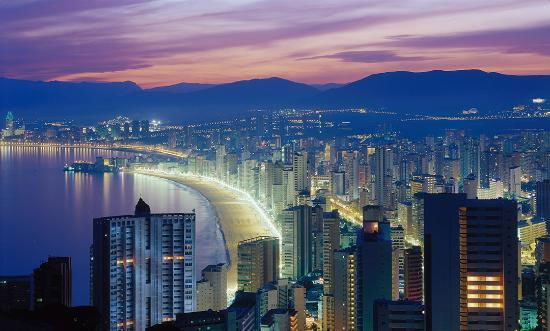
Benidorm is a resort built around its wonderful beaches, unsurpassed cleanliness and wide range of activities, all attributes we observe in its magnificent coastline. It is divided into three zones: the Levante beach, which is the most visited, extends over 2km from the historic district to the Rincon de Loix and Sierra Helada; Poniente Beach, which stretches from the historic district to the Cala de Finestrat, and Mal Pas Cove, where you can access from the port or coming downstairs from the castle.
El Campello: situated 12km from Alicante on a low rise, from where you can see a coastline of 23km with different beaches. Its landmark is a watchover, built in the Fisherman's Quarter in 1554, to alert the townsfolk of imminent attack by Barbary pirates. In the Illeta area, archaeological remains belonging to the Iberian and Greek cultures have been found.
In the 18th century, the town had its own shipbuilding yards working to encourage its seafaring tradition. Muchavista is the main beach; anyway, there are some other beaches to enjoy: The Cova del Llop Marí and Morro Creek Blanc are dipping into a rock cove. The natural environment of Lloma de Reixes is charming. An artist from Alicante Arcadio Blasco has created some spectacular sculptures, one in the sea and other on shore.
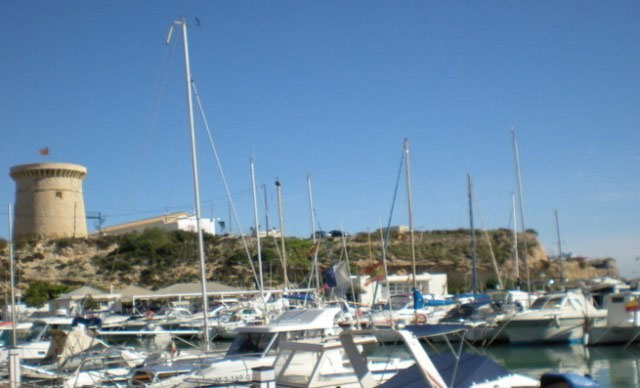
El Campello. The marina
Alicante: It is one of three provinces that form part of Valencian Community, together with Castellón and Valencia, while they are capitals of their respective provinces. It is located on the coast and has a population of 300,000. The city offers a wide variety of restaurants, pubs, cafes, clubs and many other things to have a great time. In 1998, the east of the marina was redesigned, becoming a very nice area for walking and leisure.
There are many restaurants, pubs, clubs and cafes to everyone's taste. This year also the west side of the port was remodeled turning it into a shopping and entertainment area that offers a wide range of possibilities. From the port there is an incredible view of the city and the Castle of Santa Barbara. The castle is worth visiting; here you can have one of the most beautiful views of the city, while enjoying art and cultural exhibitions, dinner shows and many other events that will make your holiday unforgettable.
The city is located in the south end of the Valencian Community and it has one of the biggest universities in Spain, offering to 40,000 students a variety of courses, including human and social sciences, medicine or engineering and medical studies, among others. The campus also offers a huge variety of cultural, scientific and research activities throughout the year, even in the summer.
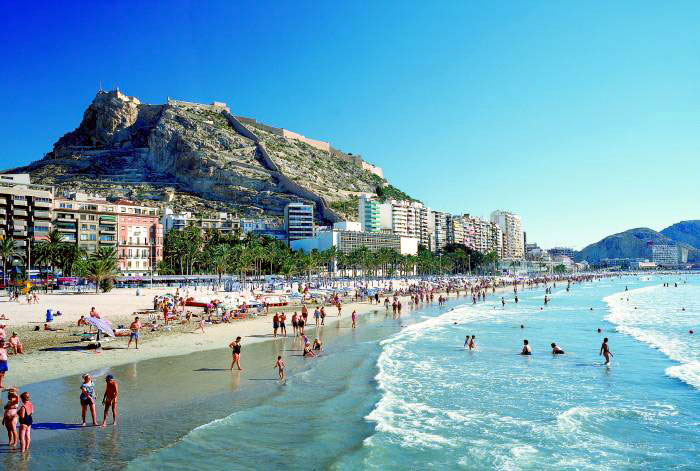
It should be mentioned that the climate of Alicante is excellent, with an average temperature of 18 ° C in winter and 32 ° C in summer.
Los Arenales: It is one of the most beautiful beaches of the Costa Blanca and it is only 15 minutes away from Alicante and 10 minutes from Elche. It offers a quiet and relaxing environment surrounded by golden beaches and stunning views from the top of the cliffs, where risk and adventure lovers can enjoy paragliding. It is mainly a holiday area that offers all kind of shops and entertainment for all ages.
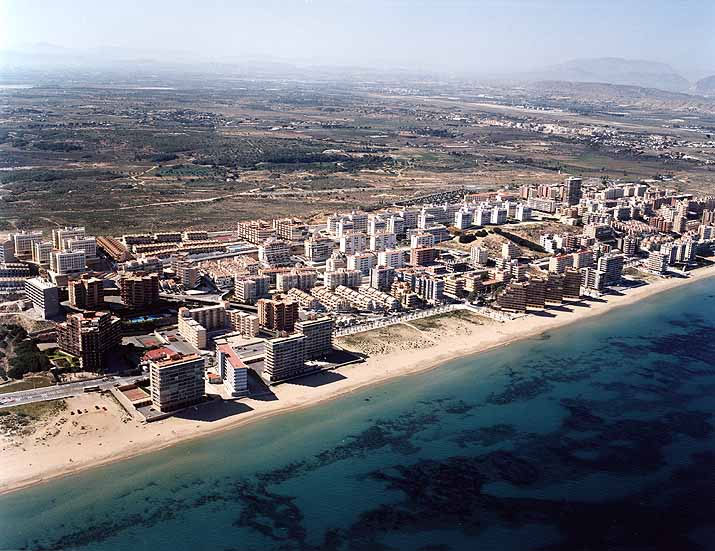
Los Arenales beach.
Santa Pola: It is a charming little village, situated on the coast 17km south of Alicante and 10km from Elche, famous for its mountain landscape, sand dunes, and above all, for its salterns. It has also 4km of beaches with fine sand and clear water. All these beaches offer different services and recreational areas.
We want to mention especially Lisa Beach, where you can go walking knee-deep in the sea. You will also find a nudist beach, called Brac del Port / La Gola. Santa Pola has an important fishing port with the major number of fishing boats around the Mediterranean Sea.
It also has a sixteenth century castle which is part of the fortification of the old quarter, with the ruins of "Portus Ilicitanus", the ancient port city of Elche in Roman times. Near the coast of Santa Pola there is Tabarca, which belongs to the province of Alicante. Berber Muslims used this island as a hub, but today it is a magnet for divers, as it is considered a marine reserve because of the rich variety of flora and fauna that surrounds the island.
An interesting observation is that the pink color of water is not an optical illusion. This coloration is due to a microorganism, a plankton-like crustacean called Artemia Salina, that lives in the lagoon. On the way to Torrevieja you will see a blue jumper, currently used as a conveyor belt that carries salt from the laundry located to the right of the road, up to the mounds where salt is stored, to the left side. Dark mounds are salt extracted from the gap yet to be washed, while the white ones are the result of this process, the salt is ready for sale.
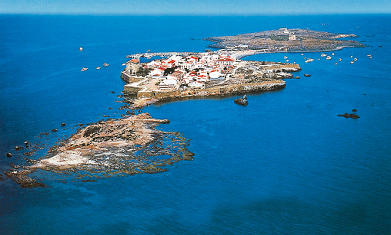
Tabarca Island
La Marina: La Marina is a small town of 1,200 inhabitants in the municipality of Elche, 13km from the city center, 20km north of Torrevieja and about 18km south of Alicante International Airport. The dunes and beaches of fine sand and clean water have an extension of about 3km. The production of pottery is the traditional craftsmanship of the Marina area.
There are a multitude of shops where you can find all kinds of plates, cups, bowls, etc., in all sizes and with the classic Mediterranean ornament. There are all kinds of shops for your daily needs, just as a taxi rank, banks, tennis courts, swimming pools, bowling alleys and a car rental office, among others. International prestigious campsite "La Marina" is located here. This area attracts people of many different nationalities who choose their properties both to live permanently as to spend a perfect holiday.
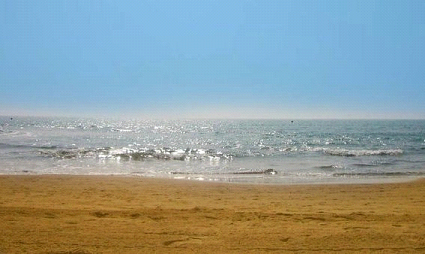
Marina Beach.
Guardamar del Segura: this summer resort is surrounded by citrus fruit orchards and fertile vegetable gardens that form a surprising contrast with rolling sand dunes along the coastline. The ancient settlement of Guardamar was inhabited first by the Iberians, occupied by the Romans and later the area became an important Morís religious centre. The Moors were ousted by Christians in the 13th century and the village was transformed into a fishing and agricultural base. The beaches of Guardamar are considered among the loveliest ones on the Costa Blanca.
The river Segura flows here into the sea, and in the evening fishermen with their fishing rods sit down, enjoying the sunsets and the beauty of the natural landscape. Special mention is worth the famous Prawn of Guardamar, a typical dish of this place, several times awarded internationally by important culinary awards.
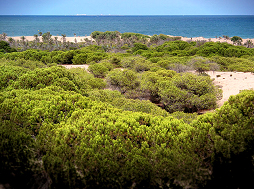 Guardamar Dunes
Guardamar Dunes
Torrevieja: es un importante centro urbano, ubicado a 48km al sur de Alicante. Sus playas, restaurantes, Museo de la Semana Santa, Museo del Mar y Sal, su agitada vida nocturna en el período estivo y su amplia oferta de diferentes actividades convierten a esta ciudad en un popular atractivo turístico. Las salinas de Torrevieja son las más grandes y las más antiguas de Europa. Hay dos parques naturales en los alrededores de la ciudad (Lagunas de la Mata y Torrevieja), donde se alimentan más de 250 especies registradas de aves.
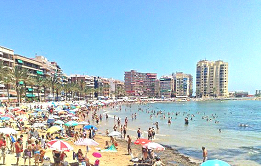
Playa del Cura, Torrevieja
Orihuela Costa: Few kilometres away from the town of Orihuela you’ll find 16 km. of coastline, where sandy beaches and majestic cliffs offer the best possibilities to enjoy the sea. There are many urban areas, such like Villamartín, Campoamor, La Zenia, Cabo Roig or Punta Prima. Year after year the beaches of Orihuela Costa have been awarded by European Blue Flag, a distinction given by the Foundation for Environmental Education for water quality, cleanliness and the large amount of existing services.
Orihuela is well known for its golf installations. There are 3 golf courses with 18 holes of the highest standard, with all the services required by this sport: golf teachers, club hire, caddies, shops, nearby hotels etc.
In the centre of Orihuela Costa there are many large shopping areas, restaurants, bars, nightclubs and a vibrant nightlife, all together offers a broad range of leisure and entertainment for young and old.
You can practice many sports: sailing, surfing, kite surfing or windsurfing, rent boats, canoes and jet skis, fishing, diving and snorkelling, golf, tennis, horseback riding, hiking, climbing, paragliding, ballooning. Orihuela Costa has the facilities and companies that allow you to make sports such as carting, paintball, quads, jet skis, bungee jumping, go-kart track.
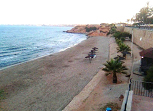
Flamenca Beach
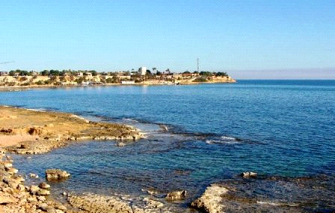
Cabo Roig
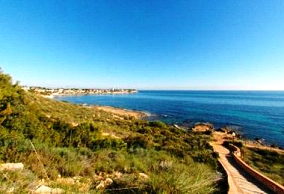
Punta Prima
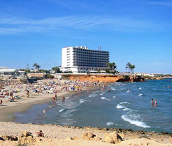
La Zenia
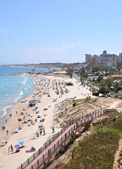
Playa de Campoamor
| © Spainshopper 2025 | About Us | Terms of Use & Privacy | Sign in | Become a partner | Site Map | News | |
|
||||||
|
|||||||